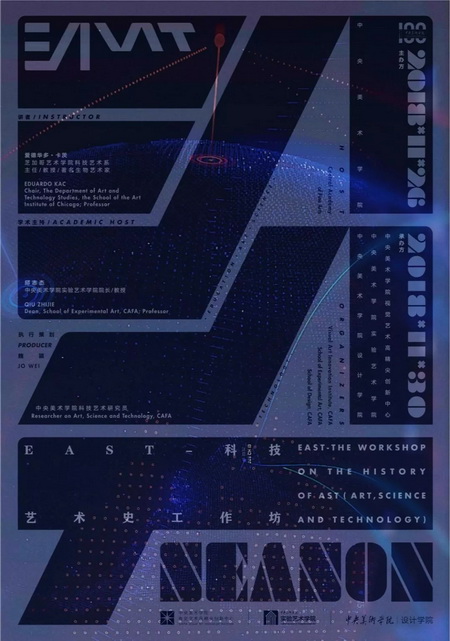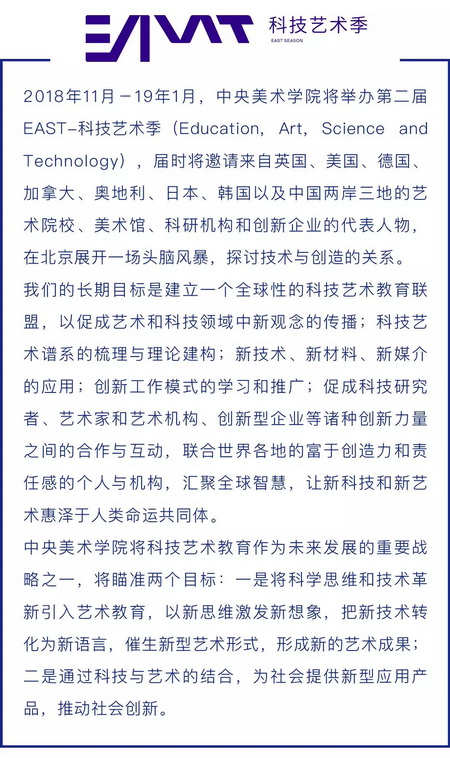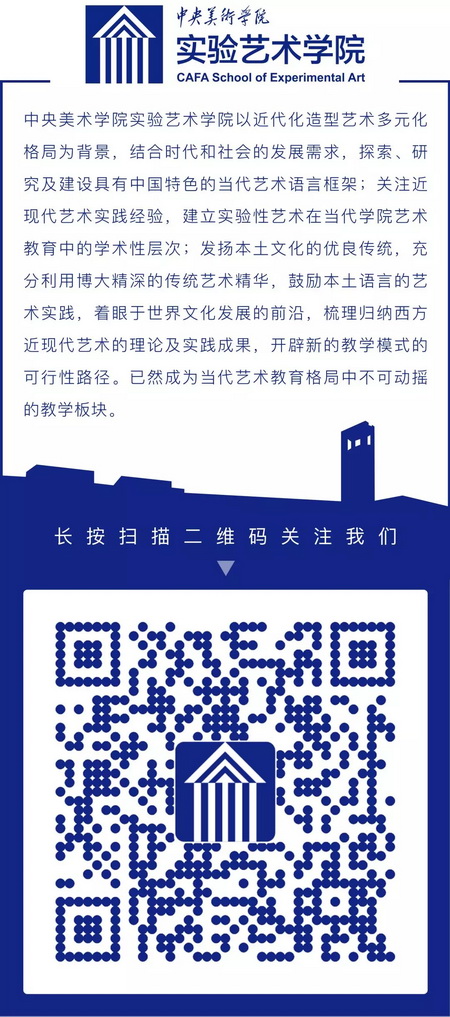
课程时间:2018.11.26-30
科技艺术史工作坊
讲者:
爱德华多·卡茨(芝加哥艺术学院科技艺术系主任、教授、著名生物艺术家)。
爱德华多·卡茨教授以生物艺术和遥现艺术闻名全球。在80年代的前互联网时期,卡茨是电信艺术的先驱,而在90年代早期他则以混合机器人远程控制技术和活体生物的前卫作品而著称。他前瞻性地将机器人、生物学和网络技术整合,并探索了后数字时代的主体位置的流动性。他的创作包含:从线上经验的神话诗学(《维拉普鲁》)到生物技术的文化冲击(《创世纪》),从数字时代记忆的变化不定(《时间胶囊》)到分散的集体能动性(《传送未知状态》);从“异国”的问题性概念(《Rara Avis》)到创造生命与进化(《绿色荧光蛋白兔》)。
在21世纪之初,卡茨为当代艺术开创了一个新方向——“转基因艺术”。第一件突破性的转基因作品名为《创世纪》(1999年),其中包含了他创造的一个“艺术家基因”,之后他又创作了名为“阿尔巴”的荧光兔(2000年)。
卡茨的作品在全球范围内展出并见诸于各大艺术媒体和主流媒体,并曾获得媒体艺术界的最高奖项-金尼卡奖。
学术主持:
邱志杰 (中央美术学院实验艺术学院院长、教授)
执行策划:
魏颖 (中央美术学院科技艺术研究员)
课程时间:
11月26-30日
(周三晚上将有一个公开讲座)
课程介绍:
本课程旨在考察新技术对20及21世纪美学的影响。课程将探讨的问题包括合成图像空间的结构,于全球性的范围创作,回应纯粹的光图像,运动的美学,虚拟环境中的行为以及互动艺术的体验。一些案例着重于特定的新媒介和相关的艺术方法;另一些则强调艺术家及其实验性工作。主要的演讲题目包括:拉兹洛·莫霍利-纳吉(Moholy-Nagy)的作品,早期无线电和听觉图像的影响,动态艺术,机器人艺术,电讯艺术,计算机艺术,数字摄影,虚拟现实,遥现艺术和全息艺术。该课程将以上理论及作品置于现当代艺术的宏大语境下,并结合演讲和讨论形式,通过电影、照片、视频和音频作品的呈现,批判性地去审视新技术与视觉艺术之间的关系。
课程安排:
第一日 电磁图景
上午:无线电和非具身的声音
下午:拉兹洛·莫霍利-纳吉:从电话图像到光与空间的调节器
第二日 动态艺术:从再现到真实的运动
上午:从再现到真实的运动-第一部分
下午:从再现到真实的运动-第二部分
第三日:新图像:电子、数字和光子图像
上午:电视和录像:艺术与大众媒体
下午:计算机艺术:从数字图像到互动以及VR
第四日:行为、意识与互动性
上午:艺术与机器人学:行为美学
下午:电信,网络艺术和遥现:实时全球化
第五日:从活体艺术到生命作为艺术媒介
上午:赛博表演:技术与身体
下午:生物艺术
EAST-Workshop on the History of Art, Science and Technology
Speaker:
Eduardo Kac (Chair, The Department of Art and Technology Studies, the School of the Art Institute of Chicago; Professor)
Eduardo Kac is internationally recognized for his telepresence and bio art. A pioneer of telecommunications art in the pre-Web '80s, Eduardo Kac (pronounced "Katz") emerged in the early '90s with his radical works combining telerobotics and living organisms. His visionary integration of robotics, biology and networking explores the fluidity of subject positions in the post-digital world. His work deals with issues that range from the mythopoetics of online experience (Uirapuru) to the cultural impact of biotechnology (Genesis); from the changing condition of memory in the digital age (Time Capsule) to distributed collective agency (Teleporting an Unknown State); from the problematic notion of the "exotic" (Rara Avis) to the creation of life and evolution(GFPBunny).
At the dawn of the twenty-first century Kac opened a new direction for contemporary art with his "transgenic art"--first with a
groundbreaking transgenic work entitled Genesis (1999), which included an "artist's gene" he invented, and then with his fluorescent rabbit called Alba (2000).
Kac’s work has been exhibited internationally and has been featured both in contemporary art publications (Flash Art, Artforum, ARTnews, Kunstforum, Tema Celeste, Artpress, NY Arts Magazine) and in the mass media (ABC, BBC, PBS, Le Monde, Boston Globe, Washington Post, Chicago Tribune, New York Times). Kac has received many awards, including the Golden Nica Award, the most prestigious award in the field of media arts and the highest prize awarded by Ars Electronica. He lectures and publishes worldwide. His work is documented at <www.ekac.org>.
Academic Host:
Qiu Zhijie(Dean, School of Experimental Art, CAFA; Professor)
Producer:
Jo Wei (Researcher on Art, Science and Technology, CAFA)
Duration:
26-30th, November, 2018(Public Lecture on Wednesday)
Course description:
This course examines the impact of new technologies on the aesthetics of the twentieth and twenty-first centuries. Issues explored in the course include the structure of synthetic pictorial spaces, creating art in a global scale, responding to images of pure light, the aesthetics of motion, behavior in virtual environments and the experience of interactive artworks. In some cases the emphasis is on a particular new medium and the multiple artistic approaches to it; in other cases, the emphasis is on particular artists and their experimental work. Main lecture topics include: Moholy-Nagy's work, early radio and the impact of auditory images, kinetic art, robotic art, telecommunication art, computer art, virtual reality, telepresence and bio art. By focusing on the theoretical and historical implications of the aforementioned media and movements, and on the work of several artists, the course places this major trend in modern and contemporary art within its larger context. Through a combination of lectures and discussions, and presentation of films, photos, videos and audio works, we investigate critically the relationship between new technologies and the visual arts.
Course arrangement:
Day 1
The Electromagnetic Landscape
Morning
Radio and the Disembodied Voice
Afternoon
Moholy-Nagy: From the Telephone Pictures to the Light-Space Modulator
Day 2
Kinetic Art: From Representation to Actual Motion
Morning
Kinetic Art: From Representation to Actual Motion — Part 1
Afternoon
Kinetic Art: From Representation to Actual Motion — Part 2
Day 3
The New Image: Electronic, Digital, Photonic
Morning
Television and Video: Art and Mass Media
Afternoon
Computer Art: From Digital Graphics to Interactivity and VR
Day 4
Behavior, Awareness, and Interactivity
Morning
Art and Robotics: Behavioral Aesthetics
Afternoon
Telecommunications, Web Art, and Telepresence: Global Scale in Real Time
Day 5
From Live Art to Life as an Art Medium
Morning
Cyborg Performance: Technology and the Human Body
Afternoon
Bio Art



